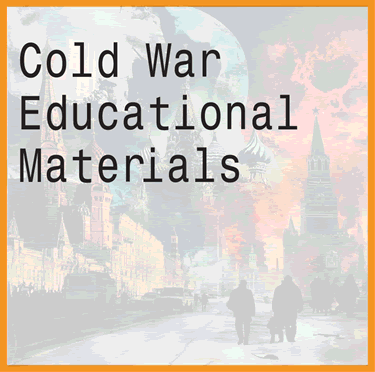 |
| Cold War Educational Materials |
|---|
| www.studenthandouts.com ↣ World History ↣ Cold War |
|---|
| Cold War Books and Films | Cold War Outlines and PowerPoints |
| Cold War Maps and Pictures | Cold War Learning Games |
| Cold War Miscellany | Cold War Worksheets |
The Cold War, a protracted ideological and geopolitical conflict between the United States and the Soviet Union and their respective allies that lasted from the late 1940s to the early 1990s, had a profound and far-reaching impact on world history in numerous ways. Our free educational materials are designed to help World History students explore, learn about, and understand the events, policies, leading figures, and effects of the Cold War and its role in global history.
 Division of the World: The Cold War divided the world into two blocs: the Western bloc led by the United States and the Eastern bloc led by the Soviet Union. This division created a bipolar international system, with each superpower vying for global influence.
Division of the World: The Cold War divided the world into two blocs: the Western bloc led by the United States and the Eastern bloc led by the Soviet Union. This division created a bipolar international system, with each superpower vying for global influence. Arms Race: The United States and the Soviet Union engaged in a nuclear arms race, resulting in the development and stockpiling of vast arsenals of nuclear weapons. The fear of mutually assured destruction (MAD) acted as a deterrent, preventing direct conflict but creating a constant state of tension. Proxy Wars: Although direct military confrontation between the superpowers was avoided, they supported opposing sides in numerous proxy wars around the world. Examples include the Korean War, the Vietnam War, and various conflicts in Africa, Latin America, and Asia. These conflicts had devastating effects on local populations. Space Race: The Cold War fueled a competition in space exploration and technology between the United States and the Soviet Union. This led to the first human spaceflight (Yuri Gagarin in 1961) and the U.S. moon landing (Apollo 11 in 1969). Spread of Nuclear Weapons: The superpower rivalry spurred other countries, such as China, the United Kingdom, and France, to develop their own nuclear weapons, contributing to the proliferation of nuclear arms. NATO and Warsaw Pact: Military alliances, such as the North Atlantic Treaty Organization (NATO) and the Warsaw Pact, were formed to counter the perceived threats from the opposing bloc. These alliances had a lasting impact on international security dynamics. Decolonization and Non-Aligned Movement: The Cold War influenced the process of decolonization in Asia, Africa, and the Middle East. Many newly independent countries sought to maintain a neutral stance in the superpower rivalry, leading to the emergence of the Non-Aligned Movement. Economic Competition: The United States and the Soviet Union engaged in economic competition, with each bloc seeking to demonstrate the superiority of its economic system. This competition extended to technological innovation, scientific research, and space exploration. Cultural Exchanges: The Cold War also led to cultural exchanges between the superpowers, including the exchange of artists, intellectuals, and athletes. This had a significant impact on the arts, sports, and popular culture. Espionage and Intelligence Agencies: The Cold War saw the proliferation of espionage activities, with intelligence agencies like the CIA and KGB playing crucial roles in gathering information, conducting covert operations, and influencing foreign governments. Crisis Moments: Several crisis moments, such as the Cuban Missile Crisis in 1962, brought the world to the brink of nuclear war. These events underscored the dangers of the Cold War and the need for diplomatic solutions. End of the Cold War: The Cold War came to an end in the late 1980s and early 1990s, largely due to the internal and external pressures that led to the dissolution of the Soviet Union. This marked a significant turning point in world history, with the United States emerging as the sole superpower. Post-Cold War World Order: The end of the Cold War reshaped the world order, leading to changes in international politics, economics, and security. It allowed for the expansion of democracy, market economies, and globalization in many parts of the world. In summary, the Cold War was a defining feature of the 20th century, with its influence extending across multiple domains, including politics, military strategy, technology, culture, and global geopolitics. Its impact on world history continues to shape international relations and global dynamics in the 21st century. |
| www.studenthandouts.com ↣ World History ↣ Cold War |
|---|








